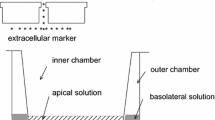Abstract
Intramembrane specializations of cultured bovine corneal endothelial cells were studied with thin section and freeze-fracture electron microscopy and related to the paracellular permeability and the transendothelial resistance (Rt) of the monolayers. The following intercellular junctions were found: single and discontinuous networks of tight junctions (TJ) which girdle the apico-lateral cell perimeter incompletely, gap junctions, and membrane undulations suggesting intermediate junctions. The macromolecular tracer ruthenium red penetrated into the lateral intercellular space beyond the level of the incomplete belt of TJ. Rt of these monolayers was 20.9±1.0 º · cm2 Protamine induced a reversible increase of Rt to 118±5 % of its control value. We conclude that incomplete belts of TJ may be the morphological counterpart of the high paracellular permeability of this monolayer and functionally and morphologically resemble those of their native endothelium. Cultured corneal endothelial cells are an excellent model for studying the influence of incomplete belts of TJ on paracellular permeability of cells.
Similar content being viewed by others
References
Bentzel CJ, Fromm M, Palant CE, Hegel U (1987) Protamine alters structure and conductance of Necturus gallbladder tight junctions without major electrical effects on the apical cell membrane. J Membr Biol 95:9–20
Cereijido M (ed) (1992) Tight junctions. CRC Press, Boca Raton, pp 1–367
Dermietzel R, Meller K, Tetzlaff W, Waelsch M (1977) In vivo and in vitro formation of the junctional complex in choroid epithelium. A freeze-etching study. Cell Tissue Res 181:427–441
Edelhauser HF, Van Horn DL, Records RE (1982) Cornea and sclera. In: Duane TD, Jaeger EA (eds) Biomedical foundations of ophthalmology, vol 1. Harper & Row, Philadelphia, pp 1–26
Fischbarg J, Lim JJ (1984) Fluid and electrolyte transports across corneal endothelium. In: Zadunaisky JA, Davson H (eds) Current topics in eye research. Academic Press, Orlando, pp 201–223
Fromm M, Palant CE, Bentzel CJ, Hegel U (1985) Protamine reversibly decreases paracellular cation permeability in Necturus gallbladder. J Membr Biol 87:141–150
Fromm M, Tykocinski M, Schulzke JD, Hegel U, Bentzel CJ (1990) pH dependence of protamine action on apical membrane permeability in Necturus gallbladder epithelium. Biochim Biophys Acta 1027:179–184
Geroski DH, Hadley A (1992) Characterization of corneal endothelium cell cultured on microporous membrane filters. Curr Eye Res 11:61–72
Gospodarowicz D, Greenburg G, Vlodavsky I, Alvarado J, Johnson LK (1979) The identification and localization of fibronectin in cultured corneal endothelial cells: cell surface polarity and physiological implications. Exp Eye Res 29:485–509
Hirsch M, Renard G, Faure J-P, Pouliquen Y (1977) Study of the ultrastructure of the rabbit corneal endothelium by the freeze-fracture technique: apical and lateral junctions. Exp Eye Res 25:277–288
Hirsch M, Tassin J, Noske W, Courtois Y (1989) Filipin-induced deformations in plasma membranes of cultured bovine corneal endothelial cells with incomplete belts of tight junctions. Exp Eye Res 49:717–727
Hodson S, Wigham C (1983) The permeability of rabbit and human corneal endothelium. J Physiol (Lond) 342:409–419
Janzer RC, Raff MC (1987) Astrocytes induce blood-brain barrier properties in endothelial cells. Nature 325:253–257
Jentsch TJ, Keller SK, Wiederholt M (1985) Ion transport mechanisms in cultured bovine endothelial cells. Curr Eye Res 4:361–369
Kaye GI, Sibley RC, Hoefle FB (1973) Recent studies on the nature and function of the corneal endothelial barrier. Exp Eye Res 15:585–610
Kreusel K-M, Fromm M, Schulzke JD, Hegel U (1991) Cl− secretion in epithelial monolayers of mucus-forming human colon cells (HT-29/136). Am J Physiol 261: C574-C582
Lim JJ, Fischbarg J (1981) Electrical properties of rabbit corneal endothelium as determined from impedance measurements. Biophys J 36:677–695
Mancel E, Hirsch M (1989) Development of tight junctions in the human ciliary epithelium. Exp Eye Res 48:87–97
Maurice DM (1984) The cornea and sclera. In: Davson H (ed) The eye. Academic Press, Orlando, pp 1–158
Narula P, Xu M, Kuang K, Akiyama R, Fischbarg J (1992) Fluid transport across cultured bovine corneal endothelial cell monolayers. Am J Physiol 262: C98-C103
Noske W, Strauß O, Wiederholt M, Hirsch M (1992) Tight junctions of cultured ciliary epithelium. Exp Eye Res 55 [Suppl 1]: 202
Noske W, Kreusel KM, Fromm M, Hirsch M (1993) Tight junctions of the corneal endothelium: morphological and electrophysiological features. German J Opththalmol 2:270
Polak-Charcon S, Shoham J, Ben-Shaul Y (1978) Junction formation in trypsinized cells of human adenocarcinoma cell line. Exp Cell Res 116:1–13
Raviola G, Butler JM (1985) Morphological evidence for the transfer of anionic macromelecules from the interior of the eye to the blood stream. Curr Eye Res 4:503–516
Shivers RR, Arthur FE, Bowman PD (1988) Induction of gap junctions and brain endothelium-like tight junctions in cultured bovine endothelial cells: local control of cell specialization. J Submicrosc Cytol Pathol 20:1–14
Stiemke MM, McCartney MD, Cantu-Crouch D, Edelhauser HF (1991) Maturation of the corneal endothelial tight junction. Invest Ophthalmol Vis Sci 32:2757–2765
Strauß O, Wiederholt M (1991) Transepithelial resistance of ciliary epithelial cells in culture: functional modification by protamine and extracellular calcium. Comp Biochem Physiol 100A: 987–993
Townes-Anderson E, Raviola G (1981) The formation and distribution of intercellular junctions in the rhesus monkey optic cup: the early development of the cilio-iridic and sensory retinas. Dev Biol 85:209–232
Waring GO, Bourne WM, Edelhauser HF, Kenyon KR (1982) The corneal endothelium. Normal and pathologic structure and function. Ophthalmology 89:531–590
Author information
Authors and Affiliations
Additional information
The results reported here were presented in part at the 91st Congress of the German Ophthalmological Society, Mannheim, 19–22 September 1993 and published in abstract form [22].
Rights and permissions
About this article
Cite this article
Noske, W., Levarlet, B., Kreusel, K.M. et al. Tight junctions and paracellular permeability in cultured bovine corneal endothelial cells. Graefe's Arch Clin Exp Ophthalmol 232, 608–613 (1994). https://doi.org/10.1007/BF00193121
Received:
Accepted:
Issue Date:
DOI: https://doi.org/10.1007/BF00193121



